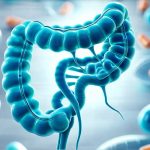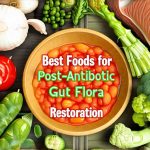Antibiotics are undeniably life-saving medications, crucial in combating bacterial infections. However, their broad-spectrum nature – designed to eliminate harmful bacteria – often doesn’t discriminate well enough. This means they inadvertently disrupt the delicate ecosystem within our gut, known as the gut microbiome. While eradicating the infection is paramount, understanding and mitigating the collateral damage to this microbial community is vital for a swift and complete recovery. A compromised gut isn’t just about digestive discomfort; it impacts immunity, mood, nutrient absorption, and even long-term health risks.
The key to navigating antibiotic recovery successfully lies in actively supporting your gut’s restoration process. This isn’t simply about waiting for things to return to normal – it’s about proactively providing the conditions necessary for beneficial bacteria to repopulate and regain balance. Diet plays a central, often underestimated role here. A plant-rich diet offers a powerful strategy to nourish the microbiome during this vulnerable period, offering building blocks for microbial diversity, prebiotic fibers to feed existing good bacteria, and compounds that can help minimize inflammation caused by dysbiosis (an imbalance in gut flora). It’s about shifting focus beyond just avoiding trigger foods; it’s about actively feeding your gut what it needs to thrive. You can learn more about finding a balanced diet to support this process.
The Gut Microbiome & Antibiotic Impact
The human gut microbiome is a complex community of trillions of microorganisms, including bacteria, fungi, viruses, and archaea, residing in our digestive tract. It’s not merely a passive passenger; it’s actively involved in essential bodily functions. These microbes aid in digestion, synthesize vitamins (like K and B vitamins), train the immune system, protect against pathogens, and even influence brain function via the gut-brain axis. A healthy microbiome is characterized by diversity – a wide range of different microbial species coexisting harmoniously. Antibiotics, while targeting harmful bacteria, often decimate beneficial bacteria as well, reducing this essential diversity and disrupting the delicate balance. This disruption can lead to several issues: – Diarrhea and digestive upset – Reduced nutrient absorption – Increased susceptibility to opportunistic infections (like C. difficile) – Compromised immune function – Potential long-term health consequences related to gut dysbiosis.
The extent of antibiotic impact varies depending on the type of antibiotic, dosage, duration of treatment, and individual factors like diet and overall health. Broad-spectrum antibiotics are particularly disruptive because they target a wider range of bacteria. However, even narrow-spectrum antibiotics can still significantly alter the microbiome’s composition. It’s important to remember that restoring gut health after antibiotics is not an overnight process; it requires consistent effort and dietary support. The goal isn’t necessarily to perfectly recreate the pre-antibiotic microbiome (which may be impossible), but rather to cultivate a resilient, diverse, and functional microbial community. Understanding stool tests can help you understand your gut better during this process.
A plant-rich diet emerges as a powerful ally in this recovery because plants provide unique compounds that directly benefit gut health. These aren’t just vitamins and minerals; they’re complex carbohydrates called prebiotics – food for beneficial bacteria – and phytonutrients with anti-inflammatory properties. This combination supports microbial regrowth, enhances the immune system, and helps to mitigate the negative consequences of antibiotic disruption.
Rebuilding Gut Diversity with Plant Foods
Diversity is arguably the most important characteristic of a healthy gut microbiome. The more diverse your microbial community, the better it can adapt to challenges, resist pathogens, and perform its essential functions. Antibiotics drastically reduce this diversity, so rebuilding it requires introducing a wide range of food sources for different types of bacteria. Plant-rich diets excel in providing this diversity because they contain an incredible array of complex carbohydrates – resistant starches, fibers, and polyphenols – that selectively feed different microbial species.
- Focus on Variety: Incorporate a rainbow of fruits and vegetables into your diet. Each color represents different phytonutrients and prebiotic fibers that support distinct microbial populations. Don’t just stick to familiar choices; explore lesser-known options like purple carrots, jicama, or kohlrabi.
- Include Fermented Foods: While not strictly “plant foods,” fermented plant-based foods (like sauerkraut, kimchi, tempeh, and miso) are excellent sources of probiotics – live microorganisms that can help repopulate the gut. However, it’s important to introduce these gradually, as they can sometimes cause temporary digestive upset in individuals with a highly disrupted microbiome.
- Embrace Whole Grains: Opt for whole grains like oats, quinoa, brown rice, and barley over refined grains. Whole grains provide fiber that feeds beneficial bacteria and supports gut motility.
A crucial aspect of rebuilding diversity is understanding the concept of personalized nutrition. While general guidelines are helpful, everyone’s microbiome is unique. What works best for one person may not work as well for another. Pay attention to how different foods affect your digestion and overall wellbeing. Keeping a food diary can help identify trigger foods or foods that particularly support your gut health. You might consider building a complete profile to understand your specific needs.
Prebiotics: Fueling Beneficial Bacteria
Prebiotics are essentially the fuel source for beneficial bacteria in the gut. They’re non-digestible fibers that pass through the upper digestive tract intact, reaching the colon where they are fermented by these microbes. This fermentation process produces short-chain fatty acids (SCFAs), like butyrate, acetate, and propionate, which have numerous health benefits: – Butyrate is a primary energy source for colon cells, promoting gut barrier integrity and reducing inflammation. – Acetate and propionate influence metabolism and immune function.
Foods rich in prebiotics include: – Onions, garlic, leeks – contain fructans – Asparagus, bananas, chicory root – contain inulin – Oats, barley, apples – contain pectin. Incorporating these foods into your diet provides a steady supply of fuel for beneficial bacteria, encouraging their growth and activity. This, in turn, helps to restore the balance disrupted by antibiotics. However, increasing prebiotic intake too quickly can sometimes cause bloating or gas, so it’s best to do so gradually. Start with small amounts and increase as tolerated.
The synergy between prebiotics and probiotics is also important. Synbiotics combine both prebiotics and probiotics in a single food or supplement, offering a more comprehensive approach to gut health restoration. While probiotic supplements can be helpful for some individuals, obtaining prebiotics through diet is generally considered more sustainable and beneficial long-term. If you are on antibiotics it’s even more important to support your gut.
Managing Inflammation & Gut Barrier Integrity
Antibiotic use often leads to inflammation within the gut due to microbial imbalance and increased intestinal permeability (often referred to as “leaky gut”). Inflammation further exacerbates gut dysbiosis, creating a vicious cycle. Plant-rich diets are rich in anti-inflammatory compounds – phytonutrients – that can help mitigate this inflammation. These include: – Polyphenols found in berries, grapes, and green tea – Flavonoids found in citrus fruits, onions, and parsley – Carotenoids found in carrots, sweet potatoes, and spinach.
Beyond reducing inflammation, a plant-rich diet supports gut barrier integrity – the protective lining of the intestinal tract. A compromised gut barrier allows harmful substances to leak into the bloodstream, triggering systemic inflammation and immune responses. Fiber from plant foods helps strengthen this barrier by providing substrate for butyrate production (as mentioned earlier). Butyrate nourishes colon cells, reinforcing the tight junctions between them and reducing permeability.
- Hydration: Adequate water intake is essential for maintaining gut health and supporting fiber’s function.
- Limit Inflammatory Foods: While focusing on adding plant foods, also minimize consumption of processed foods, sugary drinks, excessive alcohol, and unhealthy fats, which can contribute to inflammation.
- Mindful Eating: Practicing mindful eating – savoring your food, chewing thoroughly, and eating in a relaxed environment – aids digestion and reduces stress, both of which benefit gut health.
Ultimately, supporting gut health during antibiotic recovery requires a holistic approach that prioritizes dietary interventions alongside other lifestyle factors like stress management and adequate sleep. A plant-rich diet provides the foundation for rebuilding microbial diversity, fueling beneficial bacteria, and mitigating inflammation, paving the way for a swift and complete restoration of gut function and overall wellbeing. If daily life is hectic, remember to handle gut health even when busy. And don’t forget to manage stress levels.


















